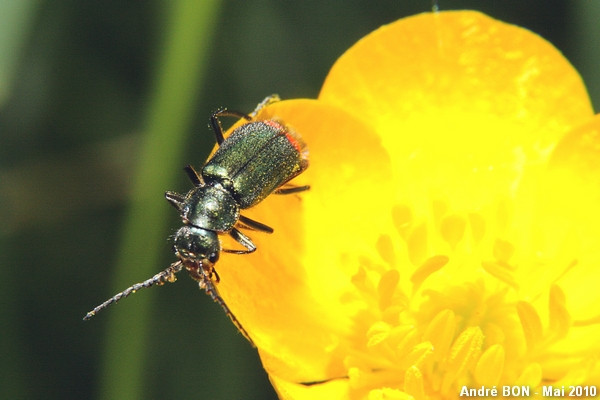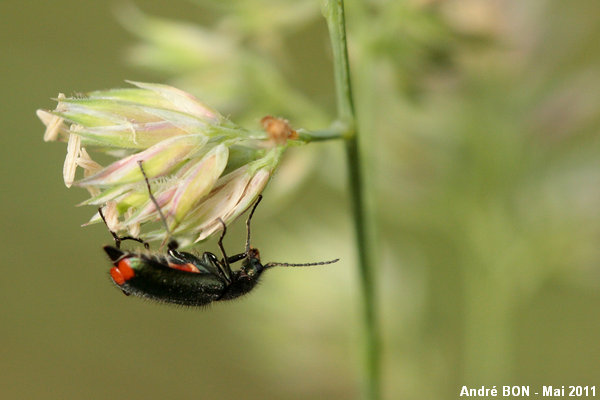

| Red-tipped Flower Beetle (Malachius bipustulatus (Linnaeus, 1758)) |


|
|
Scientific name: Malachius bipustulatus (Linnaeus, 1758) Common name: Red-tipped Flower Beetle Other names: Common Malachite Beetle French name: Malachie à deux points Order: Coleoptera Family: Malachiidae Wingspan : 5 to 8 mm. Biotope: Flower meadows, parks and gardens. Geographic area: Europe, Asia. Observation period : April to autumn, less abundant after July. |
The Red-tipped Flower Beetle is a malachite green beetle with two red patches at the tip of the elytra. The forehead is yellow. You can tell it apart from the many similar species with the two small red patches on each side of the front edge of the pronotum and with the conical shape of the first article of the antenna. Malachius lusitanicus, which is found in the Pyrénées and in Spain, has also one red patch on each fore angle of the pronotum but is shows a first antennal article which is cylindrical-shaped. The Red-tipped Flower Beetle has a rather short and wide pronotum. When threatened, it can exude a right pouch on each side and emit a bad smell to repulse the potential predators. The male's abdomen slightly exceed the elytra in length. It has pale brown flanges on the first articles of the antennae. They are used to emit sex-pheromones. The female's abdomen clearly exceeds the elytra in length. Adults feed on pollen, larvae and small insects. Females lay their eggs in crevices of dead wood. Larvae feed on other larvae of xylophagous insects. |
| [To know more about the Red-tipped Flower Beetle] [Next picture] [Top] |

|
The red patch on the front edge of the pronotum is hardly visible. The first article of the antenna is clearly conical-shaped and the French department of Yvelines is not located in the Pyrénées ;-) So this is a male Malachius bipustulatus as shown by the flanges on the antennae. |
| [To know more about the Red-tipped Flower Beetle] [Previous picture] [Top] |

|
The red patch on the front edge of the pronotum is not visible here but you can guess it on another picture of the same insect, not shown here. The first article of the antenna is conical-shaped. Does the lack of the flanges on the first articles of the antennae indicate that this one is a female? |